It’s no secret, by now you’ve probably all heard — it’s been really, really cold outside recently. Some of the coldest temperatures ever recorded, reaching as low as minus-50 degrees Fahrenheit or more, especially with wind chill, primarily across the Midwest. Flights were canceled, schools and businesses were closed, the post office didn’t deliver mail. Aside from animal care, I didn’t leave the house or start my car in four days.
But that’s just it. Regardless of record-breaking cold temps, the farm will never close. In fact, these are the times when our livestock may need us the most. From frozen waterers to tractors, trucks and skidloaders that won’t start, a lot of chores have been miserable for the farmers and ranchers out there. It’s to be expected that the chore workload would probably increase by about 20 percent due to these dreaded conditions. The cattle have frozen whiskers!
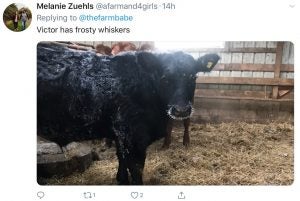
Despite the tough conditions, as always, the animals come first … even if it means you have to bring lambs in the house:
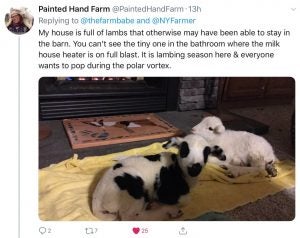
Farmers and ranchers wear many hats and must have many versatile skills, from agronomy and chemistry to economics and machinery. But one of the most rewarding skills is that of saving animals from the cold, with or without the help of a veterinarian. Here are a couple more stories sure to warm your heart:
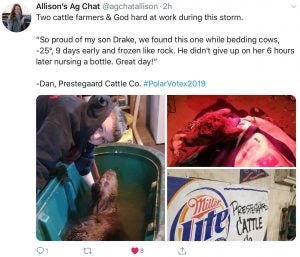
Sometimes it’s the little things … despite awful weather … that make for a great day.
As a lamb farmer myself, the following photo is all too familiar:
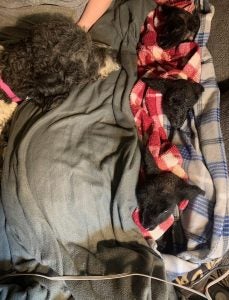
Farmer Jack Beam shared this photo of his triplet lambs, and how cute are they snuggled in the blankets with the dog in the house? Yep. As farmers it’s always to be assumed that there are many times we will bring animals in the house as their health always comes first! Usually farmers check for new lambs every couple of hours and get very little sleep during lambing time. For Jack, these lambs came in between that couple-hour timeframe. As someone who’s farming 90 ewes, Jack explains:
“It was minus-16 with a wind chill of minu-36. When I got to these lambs they were frozen stiff. Gave them a hot water bath, tube feeding, heating pad, and two of them were back out with the ewe by afternoon. One is still a little weak, so he’ll stay in the house a little longer and will probably go on a self-feeder.”
And of course, shout out to the dairy farmers out there. Regardless of circumstances the cows must always be milked!
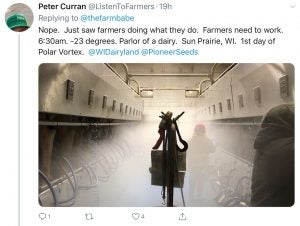
Whether a farm is large and milks thousands of cows or is a small hobby farm, everyone feels the effects. There is a reason, however, that a majority of farmers in colder climates raise livestock indoors … to protect them from these harsh weather elements! (Or predators or disease, etc.) Free range sounds like a good idea, but can be challenging during these extreme circumstances. Farmer Chad explains, and shows off the adorable chicken coop filled with everyone under one roof.
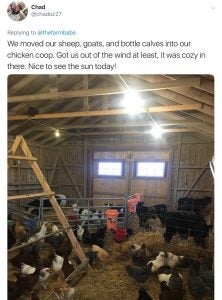
Appreciate where your food comes from. Farmers don’t get snow days, and they work very hard under very frustrating circumstances at times to make sure we all have enough to eat. Here in Iowa, temperatures have finally risen to the mid-40s, making it a nearly a 100-degree swing in just a couple of days. But that’s Iowa weather for ya! Now we will be dealing with sloppy roads, muddy pens, and livestock are at greater risk for getting sick when temperature swings are this extreme.
But we wouldn’t change this life for the world.
Michelle Miller, the Farm Babe, is an Iowa-based farmer, public speaker, and writer, who lives and works with her boyfriend on their farm, which consists of row crops, beef cattle, and sheep. She believes education is key in bridging the gap between farmers and consumers.



